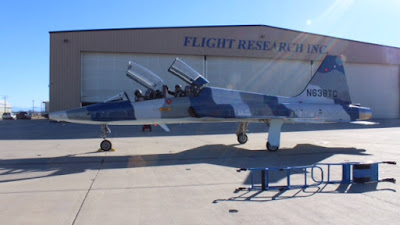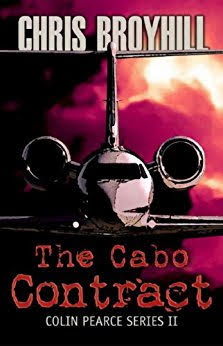Fridays Fabulous Flying...
Dr. Chris Broyhill
Chris Broyhill flew to Mohave Air and Space port (KMHV), in California, to conduct upset recovery training at the Flight Research center.
Flight Research is the premier
upset recovery training provider
in the United States.
The course Chris attended was the first offering of a new syllabus: High Performance Upset Recovery Training, where the transonic and supersonic aspects of upset recovery were demonstrated and explored. This syllabus would be flown after attending the basic course, when returning for training.
Chris says...
"The profile is flown in the Northrop T-38 Talon, the USAF high performance trainer for the last 50 years or so. The profile lasts about an hour and includes an afterburner takeoff (required for this jet), transonic handling characteristics at .9 Mach and 35,000 feet, flight characteristics as the aircraft penetrates the Mach, supersonic handling characteristics, subsonic accelerated stalls, stall buffet characteristics, clean upright stall during which sink rates of 6,000 - 10,000 feet per minute are generated (like Air France), pattern handling characteristics and then a return to base and overhead landing pattern - which is very challenging in this jet. The final turn is flown in the light buffet at .6 AOA. The benefits of this course are many. All of us operate in the trans sonic regime - above .75 Mach and at high altitude."
"Because of the limiting airspeed requirements of 14 CFR Part 25, all aircraft we fly have been tested above the Mach and have flown there during test flights. There are scenarios in which a modern aircraft could exceed the Mach and require recovery. The most valuable part of the syllabus however is seeing the difference in handling characteristics between trans sonic and supersonic flight and knowing that there is nothing to fear. The jet can be flown back into the subsonic regime easily. The other valuable part was actually seeing an upright stall, in a jet, with a very high sink rate. I was proud and honored to be student one."
"It
was a thrilling experience to be in the T-38 again.
I wrote about this jet in my second book,
The Cabo Contract."
I wrote about this jet in my second book,
The Cabo Contract."
"When I slid into that cockpit again, after 30 years, I felt like I was back home. Like I had never left. The airplane felt completely natural to me. The profile was designed to take 1.2 hours, I finished it in 1.0 because I managed the energy of the jet better than the average student would. I actually flew the pattern and landed it without assistance, although my landing wasn't quite as nice as I would have liked. "
"It was an absolutely amazing experience"
Dr. Chris Broyhill was a Friday Flyer back in 2012. At the time he had published the Viper Contract, submitted the Cabo Contract to his publisher, and was working on his PhD, while holding down a full time flying/management job. I read both the Viper Contract and Cabo Contract and loved them. I'm looking forward to reading the Satan contract... which is on its way to my home at this moment.
Chris, Thank you for sharing your experience with
This is something every pilot should experience!
Enjoy the Journey!
XOX Karlene








Hi Karlene, thanks for posting this.
ReplyDeleteFor the T-38, and I suggest other aircraft, in the situations shown to this author the most important thing is recognition. Once you recognize you're in a situation, basic training can take over.
Many moons ago, the T-38 killed many a young aviator because of it's relatively insidious characteristics in airport traffic area. Nowadays, those occurrences are non-existant because of concerted training on recognition and recovery.
For our students, we spend a weekend flying 777 and A330 sims exploring this in multiple regimes ranging from the classic Air France scenario to the transonic. (Of course you have to trick the system to allow the A330 to do this but that's the point, isn't it).
The point of all this is as awesome as the T-38 is as a platform, you can still do fantastic recognition and recovery training on ground based platforms.
Cheers
Tom
Tom, Yes, recognition is the key! So, how do I join you for that 777 simulator training? I'm still waiting for my checkout. Thank you so much for our comment!!
Delete